
"This is Frisbee. He is a tricoloured CKC-reg Papillon. Just over 3 years old here." Photo courtesy of Shayla-Skye Fines
PAP-ee-yon 
Also called the Continental Toy Spaniel, the Papillon is a small, fine-boned dog. The small head is slightly rounded between the ears with a well-defined stop. The muzzle is somewhat short and thin, tapering to the nose. The dark, medium-sized, round eyes have black rims. The large ears can either be erect or dropped with rounded tips. Papillons with drop ears are called Phalene Papillons (Moth). The hair on the ears is long and fringed, giving it a butterfly-like look. The teeth meet in a scissors bite. The long tail is set high, carried over the body and covered with long hair. Dewclaws are sometimes removed. The straight, long, fine, single coat has extra frill on the chest, ears, back of the legs and the tail. Coat color is white with patches of any color except for liver. A mask of a color other than white covers both ears and eyes from back to front.
The Papillon is sometimes called the butterfly dog, because the ears look like butterfly wings. It is a friendly, intelligent dog that is tougher than it looks, and loves outdoor exercise. It is a playful, lively, amusing, animated and charming little dog. Affectionate, gentle, patient, and proud, it loves to cuddle and enjoys a good romp outdoors. They are steady, obedient and are not yappers. Papillons can be trained to perform small tricks. Good with cats when they are socialized with them. They can also be difficult to housebreak, but are, in general, easy to train otherwise. If you allow this dog to become pack leader to humans, it may become very possessive of its owner and resent outsiders. When a dog believes he is pack leader to humans, it is called Small Dog Syndrome, human induced behaviors, where the dog is allowed to believe he owns the house. This can cause a varying degree of behavior problems such as, but not limited to, being nervous, high-strung, timid, separation anxiety, guarding, growling, snapping, biting, obsessive barking, dog aggression and being untrustworthy with children. These are not Papillon traits, but rather behaviors brought on by the way humans are treating the dog. Since most people who own small dogs, because of their size, unknowingly allow them to run the show, they are not generally recommended for young children. However, if you are your dog's firm, consistent pack leader, providing rules he must follow and limits to what he is and is not allowed to do, along with daily pack walks, the Papillon can be very trustworthy with children. They will be calm if sufficiently exercised.
Height: Males 8 - 11 inches (20 – 28 cm) Females 8 - 11 inches (20 – 28 cm)
Weight: Males 8 - 10 pounds (4 – 5 kg) Females 7 - 9 pounds (3 – 4 kg)
Sometimes prone to problems with the kneecaps (patella) in the hind legs, this can sometimes be corrected by surgery. Also fontanel (an opening at the top of the skull similar to a baby human's "soft spot"). It sometimes corrects itself but if it does not, the dog needs to be protected. Some have a difficult time under anesthesia.
Although they can be good city dogs, they are sometimes not good apartment dogs, because the dog has a strong instinct to protect their property, and many will bark excessively at nearby noises, not making the distinction between casual noises and those worthy of real alarm.
Papillons need a daily walk. Play will take care of a lot of their exercise needs, however, as with all breeds, play will not fulfill their primal instinct to walk. Dogs that do not get to go on daily walks are more likely to display behavior problems. They will also enjoy a good romp in a safe open area off-lead, such as a large, fenced-in yard.
Some as long as 16 years
About 2 to 4 puppies
Daily combing and brushing of the long, silky, single coat is important and fairly straightforward. These dogs are usually clean and odorless. Bathe or dry shampoo when necessary. Keep the nails clipped and have the teeth cleaned regularly because they tend to accumulate tartar. They are average shedders and do not mat or tangle.
The Papillon is one of the oldest breeds of dog, with a recorded history in Europe going back nearly 700 years. The breed originally only had dropped ears and was called the "epagneul nain" or "dwarf spaniel." Much of the breed's development is known because of its depiction in paintings. This tiny breed is recognizable in 13th through 15th century Italian paintings in the Renaissance period. They were often painted on the laps of French and Spanish noblewomen. The dog was later known as the Continental Toy Spaniel, which is the official name the FCI standard goes by. They were sometimes referred to as simply a Toy Spaniel. Over time, an erect-eared type, fringed as to resemble the ears of a butterfly, developed. Papillon means "butterfly" in French. The AKC calls the breed a Papillon, with Phalene being the name for the drop-eared variety, whereas the FCI calls the breed a Continental Toy Spaniel with two varieties: Papillon for the erect-eared dogs and Phalene for the drop-eared dogs. In the United States and according to the AKC standard, Papillons (erect-eared) and Phalenes (drop-eared) can be born in the same litter and are shown together as one breed. While the AKC allows for the Papillon and Phalene to mix mate, the FCI strictly prohibits mix mating because of problems with the position of the ears. One FCI breeder states, "When a Papillon and Phalene are mixed, most of the time incorrect ears on both varieties are the result, i.e. one ear erected one dropped or both bended on top or a different combination of the mentioned problems. The correct position of Phalene ears is to lie close to the side of the head showing no gap, but when you mix the two the ears they do show a gap which is called "open ears". If there are the opposite genes in either variety incorrect ears will always show up in the litters." Because of the tail’s long fringing and the way it is carried curled over the back the Papillon was once called a "Squirrel Spaniel." The Papillon was first recognized by the AKC in 1915. Some of its talents include: watchdog, agility, competitive obedience, and performing tricks.
Gun Dog, AKC Toy
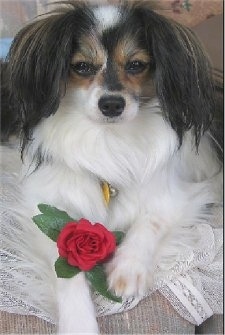
Myrna Loy, a Phalene variety
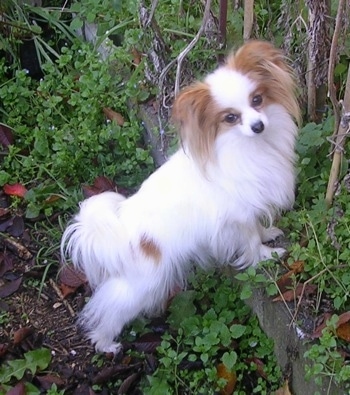
"Ruby the Papillon is very small, weighs only 4 pounds (1.98 kg.). She is an ex-show dog and is shown here at 6 years old. She has won Best in Show several times. She loves investigating outdoors and then reclining on her pink chair. I enjoy watching The Dog Whisperer and have learned a lot. Also tried some of his techniques with good success."
"This is Lotta, a FCI Papillon from Iceland. She is a one-year-old show dog and has done great in shows here in Iceland despite her young age. She is a happy little dog. She loves playing outside in our big yard and she loves going on long walks. She is a strong little dog and has even gone with us on a 7-hour-long hike/walk which was no problem for her. Lotta is an active dog but she is well balanced so she is also calm and quiet. She loves her "big sister," which is a Golden Retriever / Labrador mix, very much and they are great together. Lotta loves everybody and isn't shy with people at all. She is a stubborn and a strong-minded little lady but she knows we are her leaders. Lotta loves playing but she also loves to cuddle with her owners. Lotta proves that little dogs CAN be just as efficient, obedient and playful as any other larger dog. Lotta is a balanced dog, since she gets enough exercise, discipline and of course also a lot of affection. I have watched the Dog Whisperer and those shows taught me a lot about how the dog mind works and how me and my family have to make sure our dogs understand we are their leaders."
Lotta, a FCI Papillon from Iceland
Lotta, a FCI Papillon from Iceland
Limit the Papillon at about 2 years old
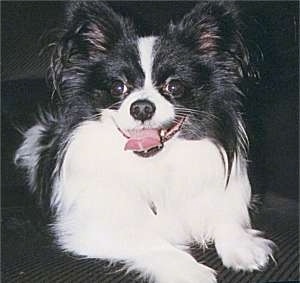
Gizmo the Papillon from Scotland

Four-month-old Gizmo the Papillon puppy
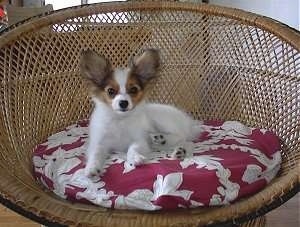
This is Indy a.k.a. Westway Indian Outlaw at 12 weeks.
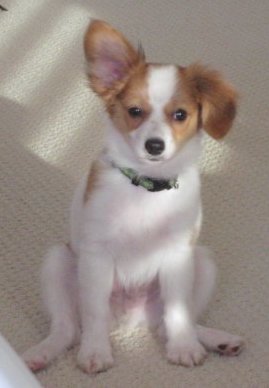
"This is Louis, my 4-month-old Papillon puppy. He is a little bit on the big side at 6 pounds already! As you can see, his ears are still coming up, with one up and one down :) He is very lively and sweet and loves playing outside. He is not very fond of rain though! When he is tired he will just come up to you and lay down in your lap exposing his belly for a rub. Louis's training is coming along wonderfully and he's always eager to please."